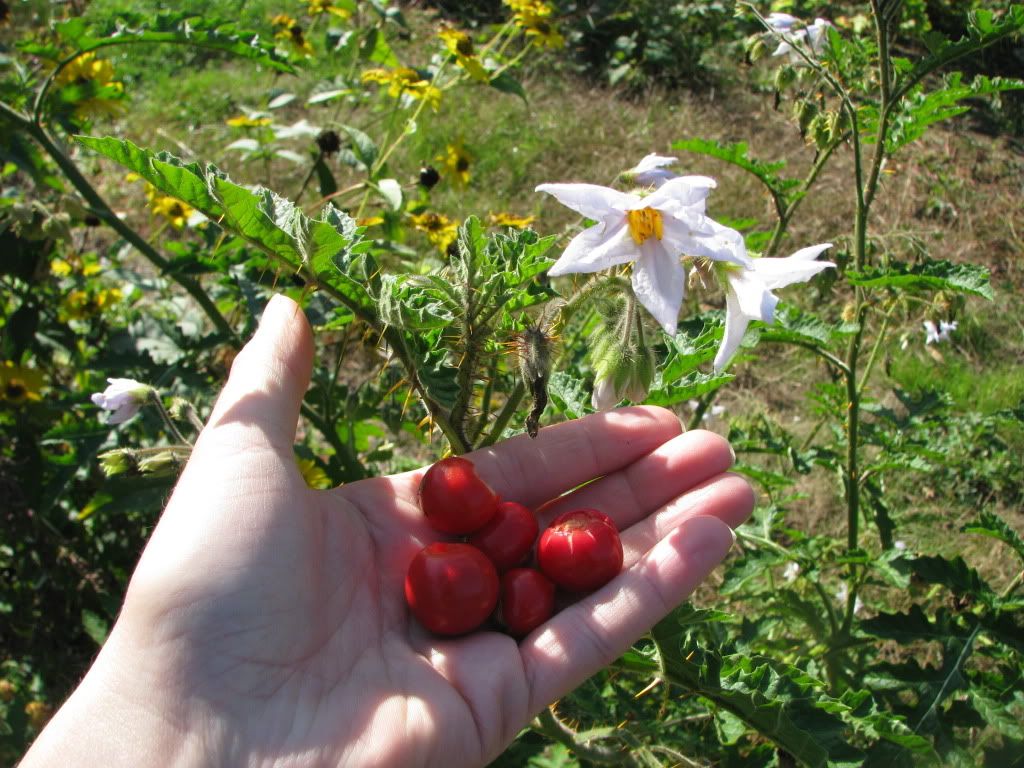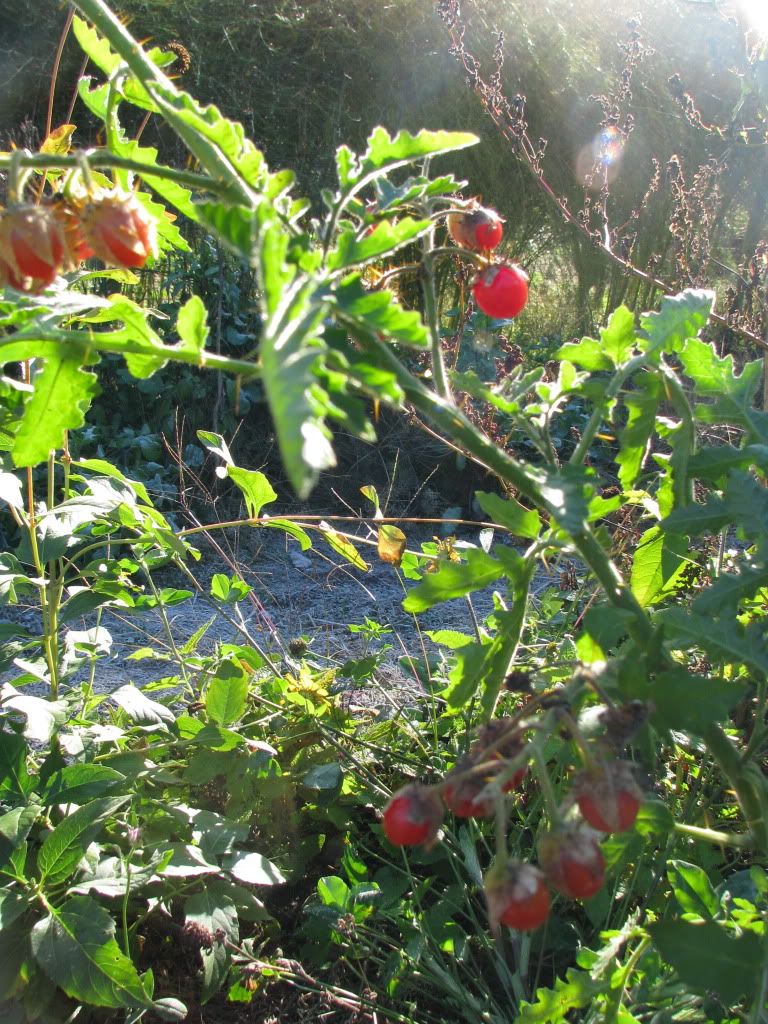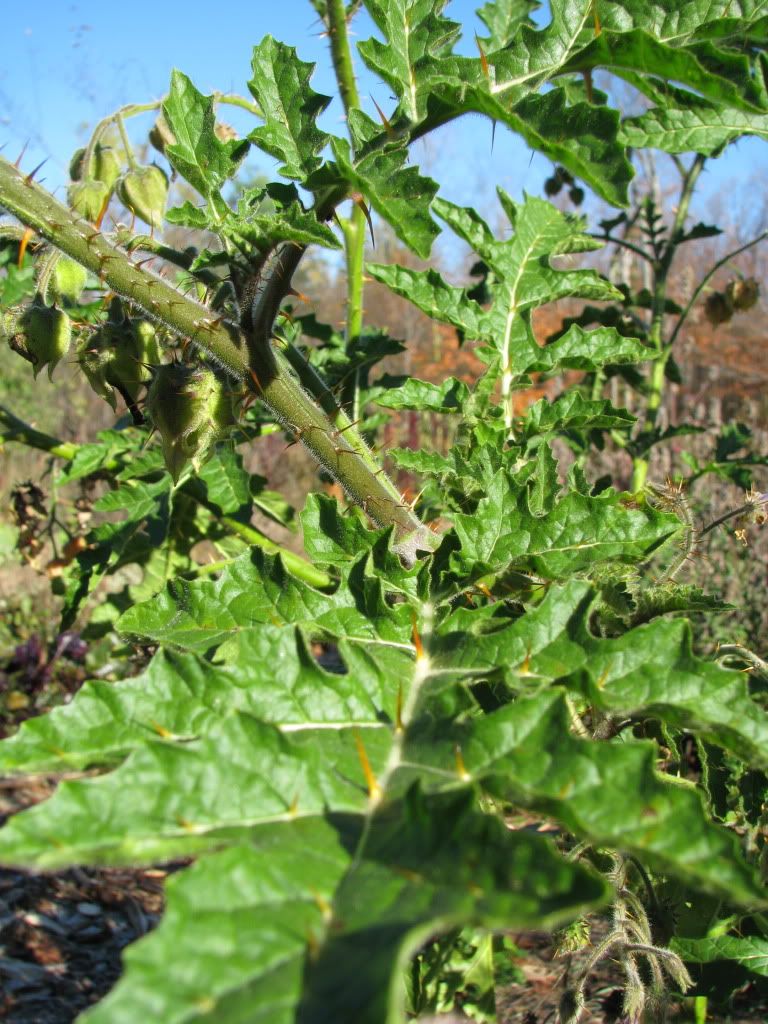
The important bits: flowers, fruit and spiny leaves. Not my ungloved, unscathed hands. Not a fast procedure harvesting to avoid punctures but possible.
It sure doesn't look like any tomato you've ever grown before because it isn't though it is related. Litchi Tomato, aka Morelle De Balbis, known in proper gardenize as Solanum sisymbriifolium bears reams of tasty, juicy and somewhat seedy red fruit guarded by pretty and poky yellow spines. The whole plant is covered with them in fact with the exception of the large bluish white flowers.
To get your taste of these fruits, you will have to get ahold of some seeds (I probably have a few to share), start at the same time as tomatoes and plant out after last frost. It'll begin small and innocent enough but after a few months, it will be between the size of a tall kid or a giant adult depending. Mine have all been around 4 feet though I've heard at least one report of 8 feet. Harvesting the fruit is a delicate matter of avoiding the spines but they are a wonderful addition to the solanacaea fruit collection such as ground cherries and tomatillos. I made a sauce with tomatillos, litchi tomato and apples with a squeeze of orange juice that was reminiscent of cranberries.

If you look in the background, you'll note hoar frost on the ground. In the foreground, an unphased Litchi Tomato plant.
It's taste is often described as being similar to cherries, or at least a cherry crossed with a tomato, with a pleasantly (in my mind) seedy raspberry overtone. It will continue to pump out the bee friendly flowers and tasty fruit until AFTER first frost. That's right, if you live in a mild climate, you may be more weary of planting this thorn machine because it will survive several degrees below zero celcius.
It's thorniess could be seen as an advantage if placed at the edge of the garden to discourage larger, thinner skinned visitors like other people or perhaps a thorn weary racoon... Anyone who happens to grow a slightly less prickly variation wcould be pretty popular as this plant could benefit from a little refinement to make it less painful to pick with easier detachment from the husk, earlier and more prolific. I've heard different stories on its taste too that could be related to growing conditions or genetic variation - probably both.
When I used to garden in a city community plot, I noted the Colorado potato beetle liked them - you could see this as a trap crop or as a problem - but I haven't seen the same issue on my rural property. They would potentially be subjected to the same pests and diseases as other tomato relatives though I haven't noticed any foliar diseases but they may harbour them.

A close up of the leaves after light ground frost showing no damage but certainly possible damage to you if you were to fall into it.
I grow it as a tasty 'trail' treat as I walk through my garden or an ingredient in salads and other dishes that could benefit their fruity flavour, and as a pretty addition to the productive beds. Then again, I have a thing for thistles and their prickly friends.
***
My source was La Societe des Plantes
There are a few other Canadian sources listed on Seeds of Diversity

3 comments:
I think that the thing that surprised me the most about this plant was how frost hardy it was. I even hilled soil and leaves around the roots to see if it they would over winter...they didn't, but it was worth a try.
We did not grow litchi tomatoes this year but will do so again the next as I missed seeing them in the garden. I like the way you described the sauce you made and will have to remember to try that. Like you, I also thought the fruits had a pleasant flavor to them. So glad you where able to experience growing this most unique plant.
Mr. H. I was hoping to visit your hyperlink but blogger tells me I can't. If you come back, please post a link. Thanks!
Growing one of these in South Florida right now. It is just starting to fruit. I picked up the immature plant at a farmer's market and was never sure what it was. Now I know. Thanks!
Post a Comment